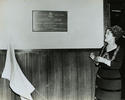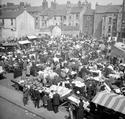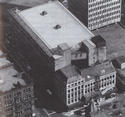Personalities
By Irene Maver
 For a city of over a million people between 1914 and the 1950s it was inevitable that Glasgow would produce many influential and colourful personalities. However, the outbreak of war in August 1914 concentrated energies on the city's distinctive military and productive capabilities. James Dalrymple (1860-1934), manager of Glasgow Corporation Tramways' Department, was a major driving force in the campaign to attract volunteers into the armed forces. An astute publicist, Dalrymple raised a battalion of the Highland Light Infantry from the ranks of the tramwaymen and employed women to replace them for the duration of the conflict.
For a city of over a million people between 1914 and the 1950s it was inevitable that Glasgow would produce many influential and colourful personalities. However, the outbreak of war in August 1914 concentrated energies on the city's distinctive military and productive capabilities. James Dalrymple (1860-1934), manager of Glasgow Corporation Tramways' Department, was a major driving force in the campaign to attract volunteers into the armed forces. An astute publicist, Dalrymple raised a battalion of the Highland Light Infantry from the ranks of the tramwaymen and employed women to replace them for the duration of the conflict.
Industrialists
 During the war Glasgow's industrial workforce was preoccupied overwhelmingly with munitions' manufacture. William Beardmore (1856-1936), later Lord Invernairn, headed one of Europe's largest steel enterprises, producing armaments, ships and aeroplanes. Similarly William Weir (1877-1959), later Lord Weir, directed the family's engineering works in Cathcart towards extensive shell output. His organisational abilities were recognised by the Government, and in 1915 Weir was brought into the Ministry of Munitions. Joseph P Maclay (1857-1951), later Lord Maclay, was another Glasgow entrepreneur who took on a key Government role as Minister for Shipping.
During the war Glasgow's industrial workforce was preoccupied overwhelmingly with munitions' manufacture. William Beardmore (1856-1936), later Lord Invernairn, headed one of Europe's largest steel enterprises, producing armaments, ships and aeroplanes. Similarly William Weir (1877-1959), later Lord Weir, directed the family's engineering works in Cathcart towards extensive shell output. His organisational abilities were recognised by the Government, and in 1915 Weir was brought into the Ministry of Munitions. Joseph P Maclay (1857-1951), later Lord Maclay, was another Glasgow entrepreneur who took on a key Government role as Minister for Shipping.
Red Clydesiders...
 Relations between management and workforce were often strained within the pressurised context of wartime manufacturing. Moreover, the lines between industrial militancy and political action were frequently blurred. The emergence of assorted "Red Clydeside" luminaries made an impact that continued into the inter-war period and demonstrated the strength of popular support for left-wing politics. In the watershed general election of 1922 ten out of the city's fifteen MPs were returned for Labour, including such forceful personalities as John Wheatley (1869-1930), James Maxton (1885-1946) and George Buchanan (1890-1955). Sir Patrick Dollan (1885-1963) became a dominating figure for Labour in Glasgow's municipal politics, serving as Lord Provost between 1938 and 1941.
Relations between management and workforce were often strained within the pressurised context of wartime manufacturing. Moreover, the lines between industrial militancy and political action were frequently blurred. The emergence of assorted "Red Clydeside" luminaries made an impact that continued into the inter-war period and demonstrated the strength of popular support for left-wing politics. In the watershed general election of 1922 ten out of the city's fifteen MPs were returned for Labour, including such forceful personalities as John Wheatley (1869-1930), James Maxton (1885-1946) and George Buchanan (1890-1955). Sir Patrick Dollan (1885-1963) became a dominating figure for Labour in Glasgow's municipal politics, serving as Lord Provost between 1938 and 1941.
Tories...
 While Labour's progress in Glasgow was helped by the democratisation of the electoral system after 1918, and by the declining fortunes of the once-powerful Liberal party, the years up to the 1950s were also characterised by the entrenched position of the Conservatives and Unionists. Indeed, the Glasgow Unionist MP Andrew Bonar Law (1858-1923) served briefly as British Prime Minister from 1922 to 1923, while his colleague Sir Robert Horne (1871-1940), later Lord Horne, was the Conservative Chancellor of the Exchequer in 1921 and 1922. The Glasgow Tories Walter Elliot (1888-1958) and Sir John Gilmour (1876-1940) were inter-war Secretaries of State for Scotland. Prominent at the municipal level was Sir Victor Warren (1903-1953), Lord Provost between 1949 and 1952.
While Labour's progress in Glasgow was helped by the democratisation of the electoral system after 1918, and by the declining fortunes of the once-powerful Liberal party, the years up to the 1950s were also characterised by the entrenched position of the Conservatives and Unionists. Indeed, the Glasgow Unionist MP Andrew Bonar Law (1858-1923) served briefly as British Prime Minister from 1922 to 1923, while his colleague Sir Robert Horne (1871-1940), later Lord Horne, was the Conservative Chancellor of the Exchequer in 1921 and 1922. The Glasgow Tories Walter Elliot (1888-1958) and Sir John Gilmour (1876-1940) were inter-war Secretaries of State for Scotland. Prominent at the municipal level was Sir Victor Warren (1903-1953), Lord Provost between 1949 and 1952.
...And Others
 Glasgow's combative politics were opened out when support for Scottish nationalism gathered momentum from the 1920s. John MacCormick (1904-1961) became secretary of the Scottish National Party after its formation in 1934 and, during the late 1940s and early 1950s, led the Glasgow-based Covenant movement, calling for Home Rule. Politics also related to community activism, and Communists Peter Kerrigan (d 1977) and Harry McShane (1891-1988) were to the forefront of the unemployed workers' movement of the 1930s. The flamboyant anarchist Guy Aldred (1886-1963) embraced a range of controversial causes, including women's access to birth control.
Glasgow's combative politics were opened out when support for Scottish nationalism gathered momentum from the 1920s. John MacCormick (1904-1961) became secretary of the Scottish National Party after its formation in 1934 and, during the late 1940s and early 1950s, led the Glasgow-based Covenant movement, calling for Home Rule. Politics also related to community activism, and Communists Peter Kerrigan (d 1977) and Harry McShane (1891-1988) were to the forefront of the unemployed workers' movement of the 1930s. The flamboyant anarchist Guy Aldred (1886-1963) embraced a range of controversial causes, including women's access to birth control.
Women
 The masculine character of Glasgow's public affairs changed only slowly up to the 1950s and there were comparatively few examples of women breaking into the front rank. It was not until 1937 that Glasgow's first female MP, Labour's Agnes Hardie (1874-1951), was returned for the Springburn constituency. Alice Cullen (1891-1969), Britain's first Catholic woman MP, won the Gorbals seat for Labour in 1948. Even at the municipal level there was scant female representation. However, prominent councillors included the socialists Jean Mann (1889-1963) and Dame Jean Roberts (1895-1988). In 1960 Roberts secured her place in the city's history by becoming the first woman Lord Provost.
The masculine character of Glasgow's public affairs changed only slowly up to the 1950s and there were comparatively few examples of women breaking into the front rank. It was not until 1937 that Glasgow's first female MP, Labour's Agnes Hardie (1874-1951), was returned for the Springburn constituency. Alice Cullen (1891-1969), Britain's first Catholic woman MP, won the Gorbals seat for Labour in 1948. Even at the municipal level there was scant female representation. However, prominent councillors included the socialists Jean Mann (1889-1963) and Dame Jean Roberts (1895-1988). In 1960 Roberts secured her place in the city's history by becoming the first woman Lord Provost.
 Women were also successful entrepreneurs, despite the perception of Glasgow as a businessman's city. Kate Cranston (1849-1934), celebrated for her "artistic" tearooms, blazed a trail up to her retirement in 1918. During the inter-war years Maggie McIver (1879-1958) created an enduring East End landmark with the "Barras" market, and in 1934 she opened the Barrowland ballroom. Female trade union leaders also emerged, especially during the Second World War, when there was extraordinary demand for women workers in industry. The Amalgamated Engineering Union first admitted women members in 1942 and AEU shop steward Agnes McLean (1918-1994) became an assertive campaigner for equal opportunities.
Women were also successful entrepreneurs, despite the perception of Glasgow as a businessman's city. Kate Cranston (1849-1934), celebrated for her "artistic" tearooms, blazed a trail up to her retirement in 1918. During the inter-war years Maggie McIver (1879-1958) created an enduring East End landmark with the "Barras" market, and in 1934 she opened the Barrowland ballroom. Female trade union leaders also emerged, especially during the Second World War, when there was extraordinary demand for women workers in industry. The Amalgamated Engineering Union first admitted women members in 1942 and AEU shop steward Agnes McLean (1918-1994) became an assertive campaigner for equal opportunities.
Writers
 Glasgow produced considerable creative talent up to the 1950s, and writers evoked starkly contrasting images of the city. The novels of Catherine Carswell (1879-1946) and Frederick Niven (1878-1944) focused on middle-class life, while James Barke (1905-1958) and George Blake (1893-1961) wrote about the working-class experience. Blake was also a journalist at a time when Glasgow produced several keenly competitive daily newspapers. Among the city's formidable media personalities was Sir Robert Bruce (1871-1955), editor of the Glasgow Herald, who in the 1930s helped to promote the high-profile campaign of police Chief Constable Sir Percy Sillitoe (1888-1962) against Glasgow's notorious gang problem.
Glasgow produced considerable creative talent up to the 1950s, and writers evoked starkly contrasting images of the city. The novels of Catherine Carswell (1879-1946) and Frederick Niven (1878-1944) focused on middle-class life, while James Barke (1905-1958) and George Blake (1893-1961) wrote about the working-class experience. Blake was also a journalist at a time when Glasgow produced several keenly competitive daily newspapers. Among the city's formidable media personalities was Sir Robert Bruce (1871-1955), editor of the Glasgow Herald, who in the 1930s helped to promote the high-profile campaign of police Chief Constable Sir Percy Sillitoe (1888-1962) against Glasgow's notorious gang problem.
Entertainers
 For all the traumatic impact of social change, entertainment was a constant and integral part of everyday life. Comedians such as Tommy Lorne (1890-1935), Tommy Morgan (1898-1958) and Dave Willis (1895-1935) represented a distinctively local music hall tradition. Drama also thrived in Glasgow, and the city's innovative approach was symbolised in 1945 by the creation of the Citizens' Theatre, under the direction of playwright James Bridie (1888-1951). With financial assistance from Sir Daniel Macaulay Stevenson (1851-1944), a former Lord Provost and noted philanthropist, the Glasgow-based Scottish National Academy of Music opened in 1929.
For all the traumatic impact of social change, entertainment was a constant and integral part of everyday life. Comedians such as Tommy Lorne (1890-1935), Tommy Morgan (1898-1958) and Dave Willis (1895-1935) represented a distinctively local music hall tradition. Drama also thrived in Glasgow, and the city's innovative approach was symbolised in 1945 by the creation of the Citizens' Theatre, under the direction of playwright James Bridie (1888-1951). With financial assistance from Sir Daniel Macaulay Stevenson (1851-1944), a former Lord Provost and noted philanthropist, the Glasgow-based Scottish National Academy of Music opened in 1929.
 Thomas Tait's (1882-1952) sleek and imaginative architectural design for the 1938 Empire Exhibition revealed the impact of technological progress. This was also reflected in leisure pursuits, especially the cinema's mass following. In 1927 the Green family emulated the latest American trends when they opened Green's Playhouse, Scotland's largest picture house. The cinema and radio were still relative novelties at the time, but competitive sport was consolidating its pre-war base of support. Benny Lynch (1913-1946) was a boxing legend after he became undisputed world flyweight champion in 1937. And, of course, Glasgow's pantheon of football heroes included Celtic's Patsy Gallacher (1891-1953), who featured in the team from 1911 to 1926, and Rangers' Willie Waddell (1921-1992), from 1938 to 1955.
Thomas Tait's (1882-1952) sleek and imaginative architectural design for the 1938 Empire Exhibition revealed the impact of technological progress. This was also reflected in leisure pursuits, especially the cinema's mass following. In 1927 the Green family emulated the latest American trends when they opened Green's Playhouse, Scotland's largest picture house. The cinema and radio were still relative novelties at the time, but competitive sport was consolidating its pre-war base of support. Benny Lynch (1913-1946) was a boxing legend after he became undisputed world flyweight champion in 1937. And, of course, Glasgow's pantheon of football heroes included Celtic's Patsy Gallacher (1891-1953), who featured in the team from 1911 to 1926, and Rangers' Willie Waddell (1921-1992), from 1938 to 1955.